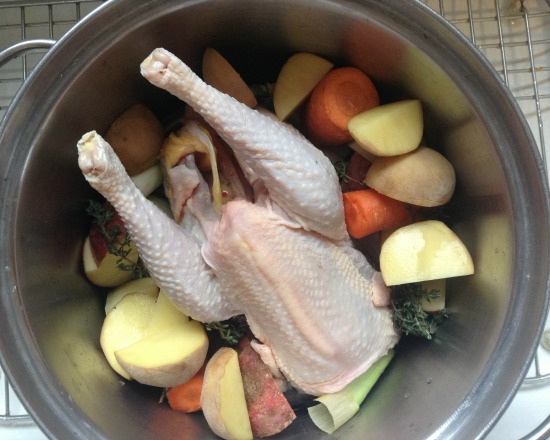
When the high stays below freezing for a week straight, I picture pots all over the northeast simmering with chicken soup. But while most Americans making stock start with the same chicken they’d also eat with a knife and fork, I’m partial to a bird of a different feather: spent hens.
Conveniently, I have my own personal livestock husband, but I first discovered spent hens a decade ago at the Greenmarket. Like most products of suburbia, I had no idea that the chickens I ate for dinner were not the same birds whose eggs I ate for breakfast.
That’s because chickens were long ago selected for two different traits. The birds we eat have been bred to quickly grow a Marilyn Monroe-style breast (no matter which sex they are). They reach slaughter weight at just six weeks, and their tender young meat is roasted long before they’re old enough to ovulate. Laying hens, on the other hand, are bred for just that, and from about three months of age, the lean ladies lay about one egg a day, an output they’ll keep up for a year or few.
Of course, laying hens don’t live forever, but they’re all but unknown in the modern diet. Because by the time a farmer decides their egg output is dwindling, they still don’t weigh what a “meat bird” weighs at just one month. And what little meat remains on their old bones is far too tough — and flavorful — for modern tastes. Which means retired layers can be harder to find than hen’s teeth.
Still, after getting to know “spent hen,” first through Greenmarket farmers, I came to understand why it’s prized in many countries: for the excellent soup stock it yields (not to mention the occasional “unlaid egg” plucked from its guts). Egg layers may wear a AA bra, but they can still offer A+ eating. It’s a pity that in our industrialized food system, they typically live a wretched life in a tiny cage, and then are tossed into pet food, compost, or the ultimate American dumping ground: school lunch.
There’s a better way. If you already buy your eggs from a Greenmarket farmer, let her know you’d also be interested in a spent hen. After living a good life out on pasture, she’ll make great soup. During “fowl” weather, simmer her up with some onions, carrots and celery, and you’ll have a broth so good, you’ll wish winter would go on forever.
She may be a tough old bird, but she shouldn’t go to the dogs. Americans would do well to have a spent hen like this in every pot.



